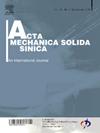Impact of Current Collector’s Surface Energy on Lithium Deposition Morphology Using the Phase-Field Method
Abstract
Anode-free lithium metal batteries are prone to capacity degradation and safety hazards due to the formation and growth of lithium dendrites. The interface between the current collector and deposited lithium plays a critical role in preventing dendrite formation by regulating the thermodynamics and kinetics of lithium deposition. In this study, we develop a phase field model to investigate the influence of the current collector’s surface energy on lithium deposition morphology and its effect on the quality of the lithium metal film. It is demonstrated that a higher surface energy of the current collector promotes the growth of lithium metal along the surface of the current collector. Further, our simulation results show that a higher surface energy accelerates the formation of the lithium metal film while simultaneously reducing its surface roughness. By examining different contact angles and applied potentials, we construct a phase diagram of deposition morphology, illustrating that increased surface energy facilitates the dense and uniform deposition of lithium metal by preventing the formation of lithium filaments and voids. These findings provide new insights into the development and application of anode-free lithium metal batteries.

 求助内容:
求助内容: 应助结果提醒方式:
应助结果提醒方式:


